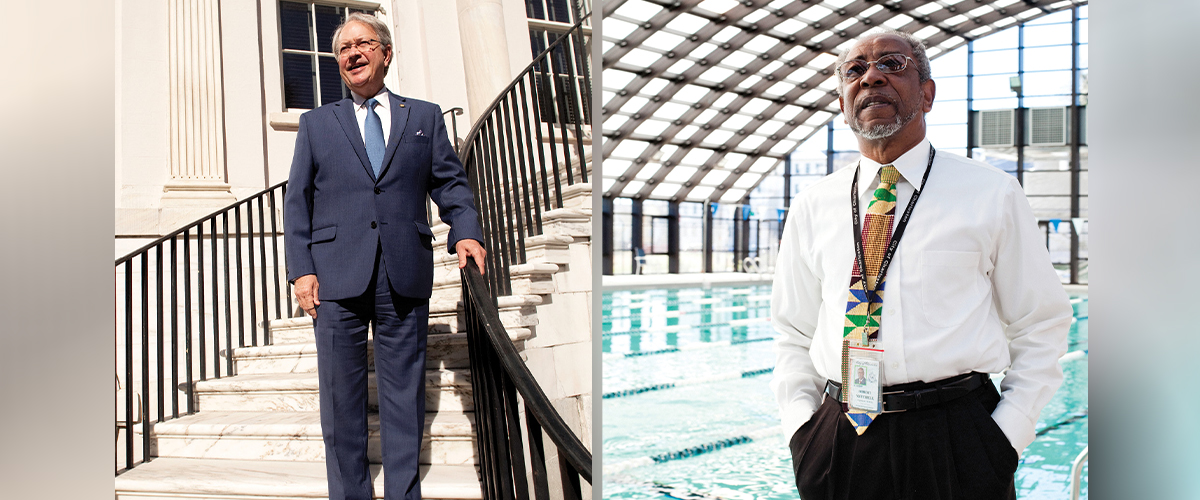WRITTEN BY Stephanie Hunt
PHOTOGRAPH BY Mira Adwell

(Left) Charleston Mayor John Tecklenburg and City Council dealt with pandemic-related budget setbacks and a city roiled by racial unrest this summer; (Right) City Councilman Robert Mitchell, pictured at the city’s renovated Martin Luther King Jr. pool, one of many ongoing construction and development projects in his district that kept him busy during the pandemic.
Mayor John Tecklenburg was barely three months into his second term when the pandemic hit. As he reflects on an unprecedented year, one in which the city had already embarked on updating its Comprehensive Plan and major flooding-related infrastructure projects, the mayor is encouraged to find the city of Charleston “in a good spot, compared to other jurisdictions that have not fared as well,” says Tecklenburg, who first issued stay-at-home orders on March 24. He believes his more proactive approach to mask mandates and following CDC guidelines has been “validated,” yet recovery remains contingent on “sticking with” precautions a bit longer to keep infection numbers down. “Even though vaccines are here and the clearing’s ahead, we are not out of the woods,” Tecklenburg cautions.
COVID dealt a $40 million loss to the city’s 2020 budget, with a projected $25 million loss for 2021, which has required the mayor and city council to “operate lean and mean,” he says. The “incredible budget balancing act” has entailed borrowing against cash reserves, cost cutting, hiring freezes, and deferring some projects to avoid having to lay off any municipal workforce. “You could argue the pandemic has revealed we are too reliant on hospitality taxes, but the city had already been diversifying our income streams, and has dealt with having our knees cut out from under us on the tourism side,” Tecklenburg says. “We expect our economy to recover nicely, and I believe we’ll be better for it in the long run.”
For City Councilman Robert Mitchell, who represents District 4, the pandemic has proved the biggest challenge of his 23-year tenure on council. He not only represents King Street’s entertainment district north of Calhoun Street, where businesses have been hit hard, but also the Midtown and Neck areas, where new development and construction has continued at a breakneck pace. Meanwhile, he’s constantly educating citizens and constituents about the need to wear masks and social distance, and hopes the council’s move to issue more citations will get people’s attention. “Day-by-day we’re figuring out what we need to add to our toolbox to keep moving forward,” Mitchell says.
“Twenty years from now, I think we will look back and see this past year as a turning point,” says Mayor Tecklenburg, “and that Charleston will be a more just and healthy place as a result.” —John Tecklenburg, Charleston Mayor
He and the mayor agree that COVID’s disproportionate impact on Black communities and people of color underscores and accentuates several of the city’s ongoing initiatives, including livability projects that encourage health and wellness, such as the Lowline, and creating more affordable housing. “We’ve been moving forward with building affordable housing units during the pandemic, but that money was already set aside. We absolutely need to do more, and can, if we find funding resources,” says Mitchell.
This summer’s protests were another inflection point, suggests the mayor, pointing to the city’s commitment to address equity, inclusion, and racial reconciliation. “After the Mother Emanuel tragedy, we were already on the path of racial healing and reconciliation, beginning with City Council’s apology for slavery, but the pandemic and the protests have pushed those efforts into a higher gear,” he says. The city has hired its first racial reconciliation manager and expects preliminary reports soon from the Special Commission on Equity, Inclusion, and Racial Reconciliation, which is charged with creating measurable outcomes and greater accountability and coordinating community-wide efforts to achieve racial equity and eliminating institutionalized racism in the city.
>>Back to The Long Strange Year article